1996 PONTIAC BONNEVILLE engine
[x] Cancel search: enginePage 80 of 387
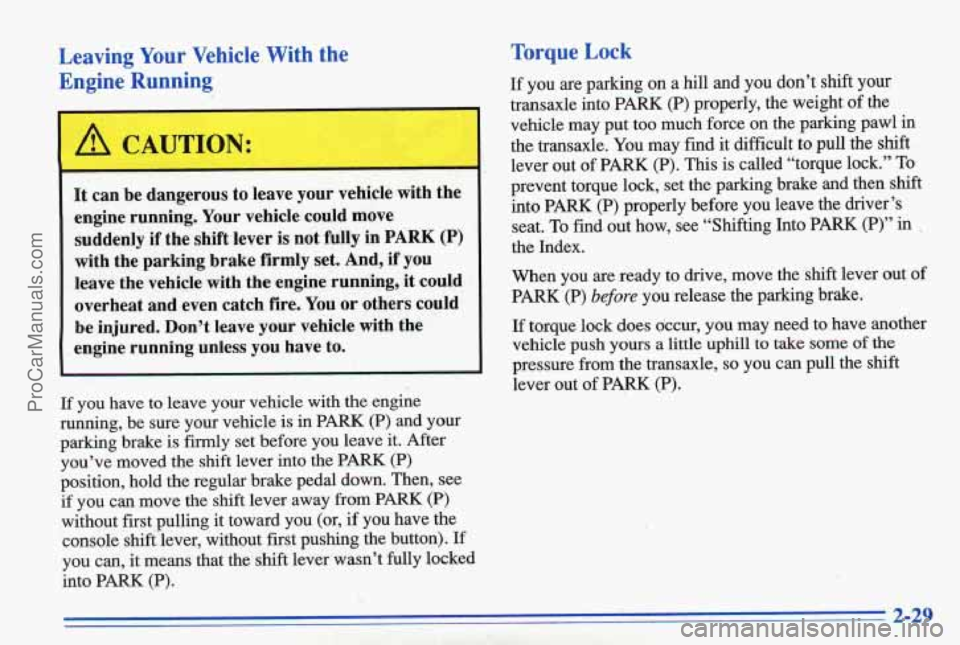
Leaving Your Vehicle With the Engine Running
c- 1
It can be dangerous to leave your vehicle with the
engine running. Your vehicle could move
suddenly if the shift lever
is not fully in PARK (P)
with the parking brake firmly set. And, if you
leave the vehicle
with the engine running, it could
overheat and even catch fire. You or others could
be injured. Don’t leave your vehicle with the
engine running unless
you have to.
I I
If you have to leave your vehicle with the engine
running, be sure your vehicle
is in PARK (P) and your
parking brake
is firmly set before you leave it. After
you’ve moved the shift lever into the PARK
(P)
Torque Lock
If you are parking on a hill and you don’t shift your
transaxle into BARK (P) properly, the weight of the
vehicle may put too much force on the parking pawl
in
the transaxle. You may find it difficult to pull the shift
lever out of PARK (P). This is called “torque lock.” To
prevent torque lock, set the parking brake and then
shift
into PARK (P) properly before you leave the driver’s
seat.
To find out how, see “Shifting Into PARK (P)” in I
the Index.
When you are ready to drive, move the shift lever out
of
PARK (P) before you release’ the parking brake.
If torque lock does dccur, you may need to have another
vehicle push
yours a little uphill to take some of the
pressure from the transaxle, so you can pull the shift
lever out of
PARK (P).
position, hold the regular brake pedal down. Then, see
if you can move the shift lever away from PARK (P)
without first pulling it toward you (or, if you have the
console
shift lever, without first pushing the button). If
you can, it means that the shift lever wasn’t fully locked
into PARK (P).
;. -i . . . . . .. . , , , , , .?..?e,: ,a ”g; .- -_- , ,.i._.. , .. . .-. -. .-:e ?, ’ . ’ .I . ’ !- , ,/ . ,, ,
., .. ,. . :.. *. -1. . ,, .. -r. -(. .. , ‘ _. *, I$ ’ I , ’. . .,. , -;-:;: i ,-.2 : < ’.* . .. , . . ,. .. , . 1 - ,.x- -.. I, ’
~ 2-29
ProCarManuals.com
Page 82 of 387
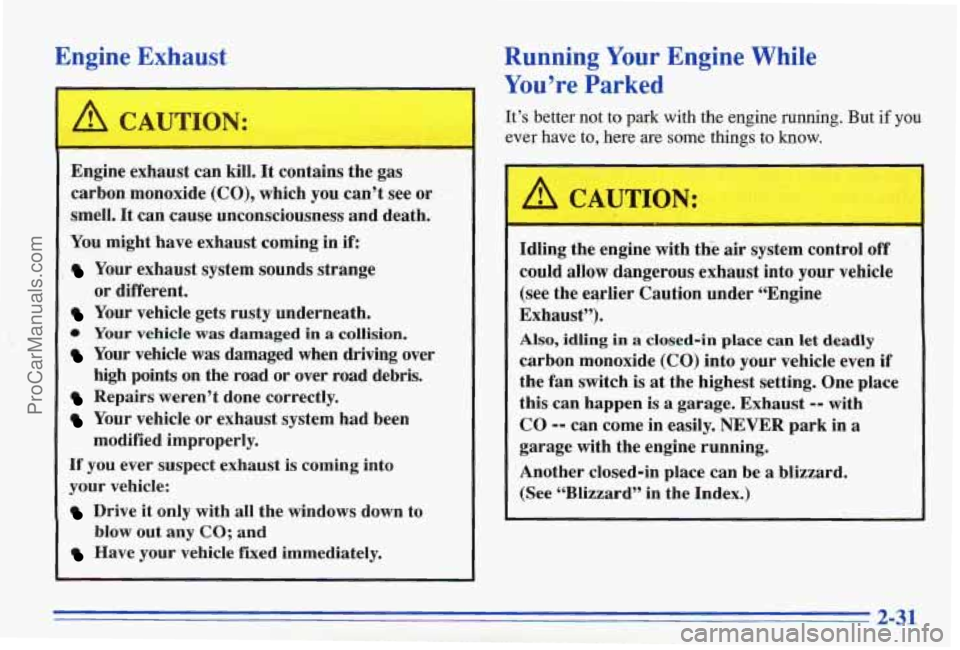
Engine Exhaust
E
Running Your Engine While
You’re Parked
It’s better not to park with the engine running. But if you
ever have to, here
are some things to know.
Engine exhaust can kill. It contains the gas
carbon monoxide
(CO), which you can’t see or
smell. It can cause unconsciousness and death.
You might have exhaust coming in if:
Your exhaust system sounds strange
Your vehicle gets rusty underneath.
0 Your vehicle was damaged in a collision.
Your vehicle was damaged when driving over
high points
on the road or over road debris.
Repairs weren’t done correctly.
Your vehicle or exhaust system had been
If you ever suspect exhaust is coming into
your vehicle:
Drive it only with all the windows down to
Have your vehicle fixed immediately.
or
different.
modified improperly. blow out any
CO; and
-
A CAUTION:,
Idling the engine with the air system control off
could allow dangerous exhaust into your vehicle
(see the eqrlier Caution under “Engine
Exhaust”).
Also, idling in a closed-in place can let deadly
carbon monoxide (CO) into your vehicle even if
the fan switch
is at the highest setting. One place
this can happen is
a garage. Exhaust -- with
CO -- can come in easily. NEVER park in a
garage with the engine running.
Another closed-in place can be
a blizzard.
(See “Blizzard” in the Index.)
2-31
ProCarManuals.com
Page 83 of 387
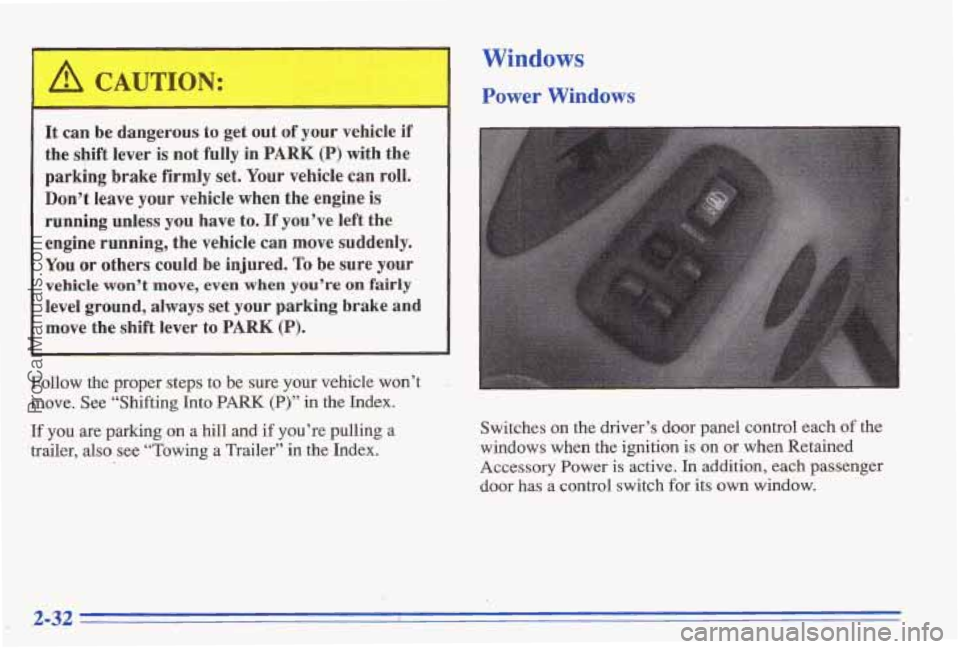
It can be dangerous to get out of your vehicle if
the
shift lever is not fully in PARK (P) with the
parking brake
firmly set. Your vehicle can roll.
Don’t leave your vehicle when the engine
is
running unless you have to. If you’ve left the
engine running, the vehicle can move suddenly.
You or others could be injured.
To be sure your
vehicle won’t move, even when you’re an fairly
level ground, always set your parking brake and
move the
shift lever to PARK (P).
Follow the proper steps to be sure your vehicle won’t
move. See “Shifting
Into PARK (P)” in the Index.
If you are parking on a hill and if you’re pulling a
trailer, also see “Towing a Trailer” in the Index.
Windows
Power Windows
Switches on the driver’s door panel control each of the
windows when the ignition is
on or when Retained
Accessory
Power is active. In addition, each passenger
door has a control switch for its own window.
ProCarManuals.com
Page 95 of 387
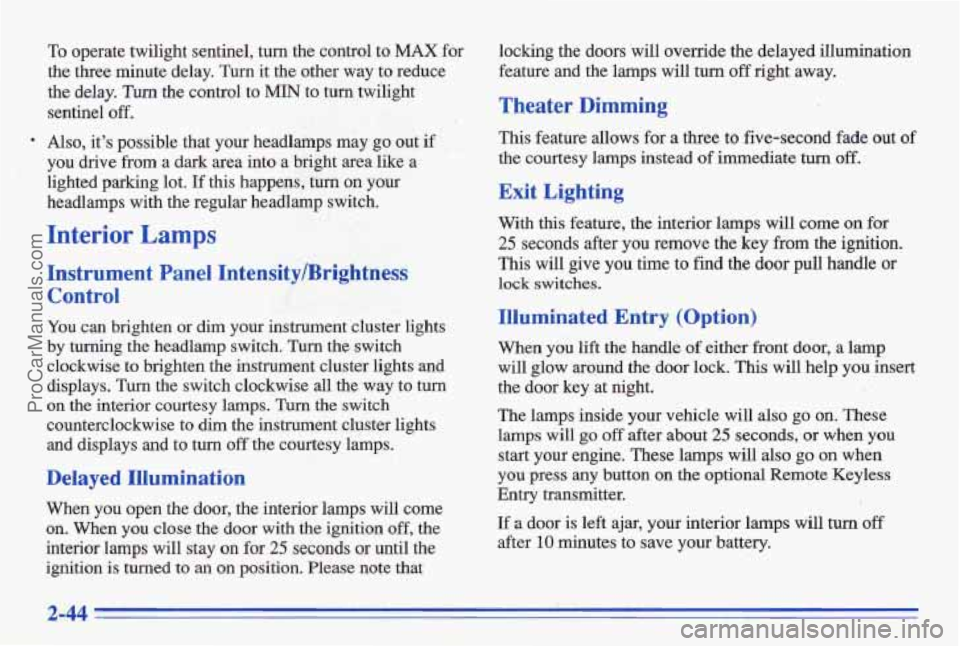
To operate twilight sentinel, turn the control to MAX for
the three minute delay.
Turn it the other way to reduce
the delay. Turn the control to MIN to turn twilight
sentinel
off.
,. Also, it's possible that your headlamps my go out if
': ,_ .:'. * , . :' you drive from a dark area into a bright area like a
' lighted parking lot. If this happens, turn on your
headlamps with the regular headlamp switch.
Interior Lamps
Instrument Panel .Intensity/Brightness
Control
You can brighten or dim your instrument cluster lights
by
turning the headlamp switch. Turn the switch
clockwise to brighten the instrument cluster lights
and
displays. Turn the switch clockwise all the way t'o turn
on the interior courtesy lamps. Turn the switch
counterclockwise to dim the instrument cluster lights
and displays and to turn off the courtesy lamps.
Delayed Illumination
When you open the door, the interior lamps will come
on. When you
close the door with the ignition off, the
interior lamps will stay on
for 25 seconds or until the
ignition
is turned to an on position. Please note that locking the doors
will override the delayed illumination
feature and the lamps will
turn off right away.
Theater Dimming
This feature allows for a thee to five-second fade out of
the courtesy lamps instead of immediate turn off.
Exit Lighting
With this feature, the interior lamps will come on for
25 seconds after you remove the key from the ignition.
This will give you time to fhd the door pull handle or
lock switches.
Illuminated Entry (Option)
When you lift the handle of either front door, a Imp
will glow around the door lock. This will help you insert
the door key at night.
The lamps inside your vehicle will also go on. These
lamps will
go off after about 25 seconds, or when you
start
your engine. These lamps will also go on when
you press any button on the optional Remote Keyless
Entry transmitter.
If a door is left ajar, your interior lamps will turn off
after 10 minutes to save your battery.
ProCarManuals.com
Page 113 of 387
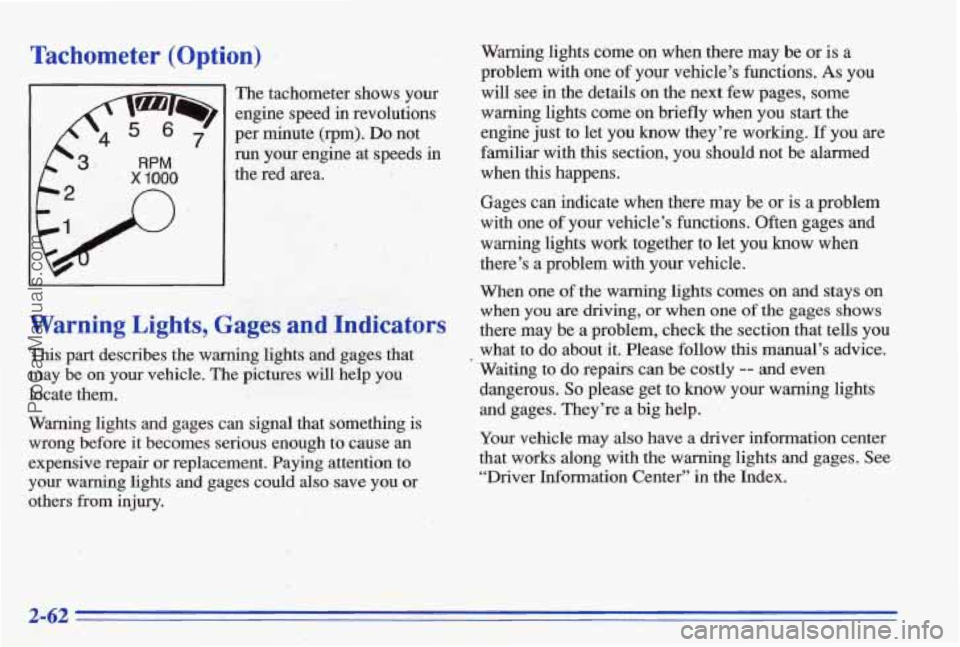
Tachometer (Option)
The tachometer shows your
engine speed in revolutions
per minute (rpm).
Do not
run your engine at speeds
in
the red area.
Warning Lights, Gages and Indicators
This part describes the warning lights and gages that
may be on your vehicle.
The pictures will help you
locate them.
Waming lights and gages can signal that something is
wrong before it becomes serious enough to cause
an
expensive repair or replacement. Paying attention to
your warning
lights and gages could &so save YOU or
others from iniurv.
Warning lights come on when there may be or is a
problem
with one of your vehicle’s functions. As you
will see in the details on the next few pages, some
warning lights come on briefly when you start the
engine just to let you know they’re working.
If you are
familiar with
this section, you should not be alarmed
when this happens.
Gages
can indicate when there may be or is a problem
with one
of your vehicle’s functions. Often gages and
warning lights work together to let
you know when
there’s
a problem with your vehicle.
When one
of the warning lights comes on and stays on
when you are driving, or when one of the gages shows
there may be a problem, check the section that tells you
what to
do about it. Please follow this manual’s advice.
Waiting to
do repairs can be costly -- and even
dangerous.
So please get to know your warning lights
and gages. They’re
a big help.
Your vehicle may also have a driver information center
that works along with the
w,arning lights and gages. See
“Driver Information Center’’
in the Index.
2-62
ProCarManuals.com
Page 115 of 387

Battery Light Voltmeter
This light will come on
briefly When you start the
vehicle: as a check'to show
you it is working; thenlit
should
go .out.
If it stays on, or comes on while you axe driving, you
may have a problem with the electrical ,chatging system.
It could indicate that you have
a generator problem or
another electrical system problem. Have it checked
right away. Driving while
this light is on could drain
your battery.
If you must drive a short distance with the light on, be
oertain to turn off all your accessories, such as the radio
and, climate control system;
Some clusters with gages
do not have a battery warning
light. They have a CHECK GAGES warning to indicate
a problem. Vehicles with- the supercharged enginealso
have
a similar battery warning light.
<-fi 18
You may have a voltmeter
unless you have the
supercharged engine.
When the engine is
running, the gage shows the
coqdition of the charging system. Readings outside the '
red warning zone indicate the normal operating range.
Readings
in the red warning zone indicate a pos'sible
problem
in the electrical system. The CHECK GAGES
light will also come on, and a warning chime will sound.
Have your vehicle serviced immediately.
when your engine is not running, but the ignition is on
(in the RUN position), the gage shows your battery's
state
of charge in DC volts.
ProCarManuals.com
Page 117 of 387
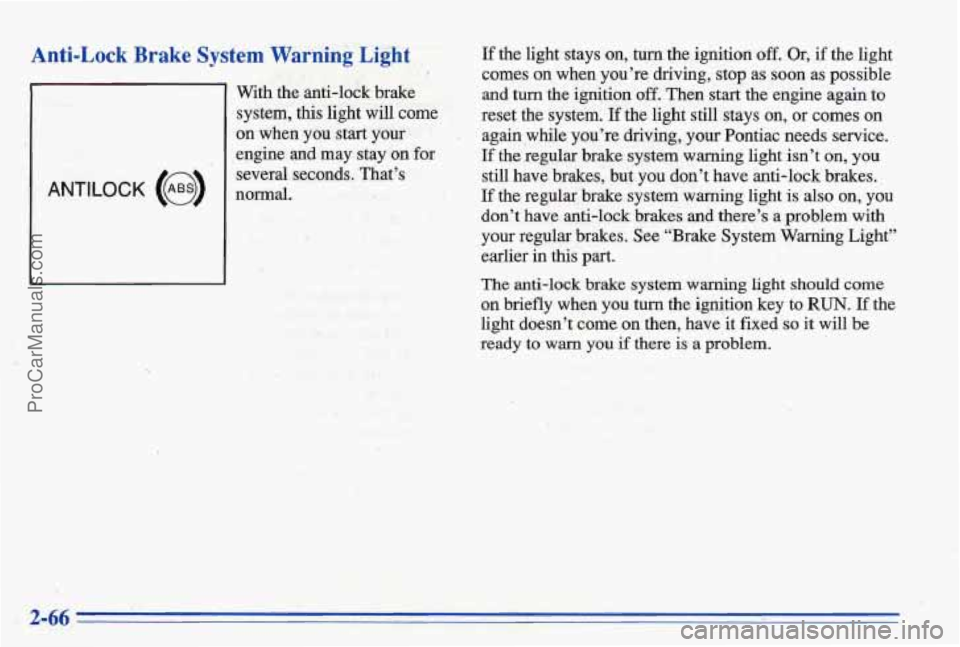
Anti-Lock Brake System Warhing Light If the light stays on, turn the ignition off. Or, if the light I comes on when you’re driving, stop as soon as possible
With the anti-lock
brake and turn the ignition off. Then start the engine again to
system, &is fight will come reset the system. If the light still stays on, or comes on
ANTILOCK (@)
1
on when you start your I again while you’re driving, your Pontiac needs service.
,engine
and may stay on for If the regular brake system warning light isn’t on, you
several seconds. That’s still have brakes, but YOU don’t have anti-lock brakes.
normal.
If the regular brake system warning light is’ also on, YOU
don’t have anti-lock brakes and there’s a problem with
your regular brakes. See “Brake System Warning Light”
earlier
in this part.
The anti-lock brake system warning light should come
on briefly when you turn the ignition key to RUN. If the
light doesn’t
come on then, have‘it fixed so it will be
ready
to warn you if there is a problem.
ProCarManuals.com
Page 118 of 387
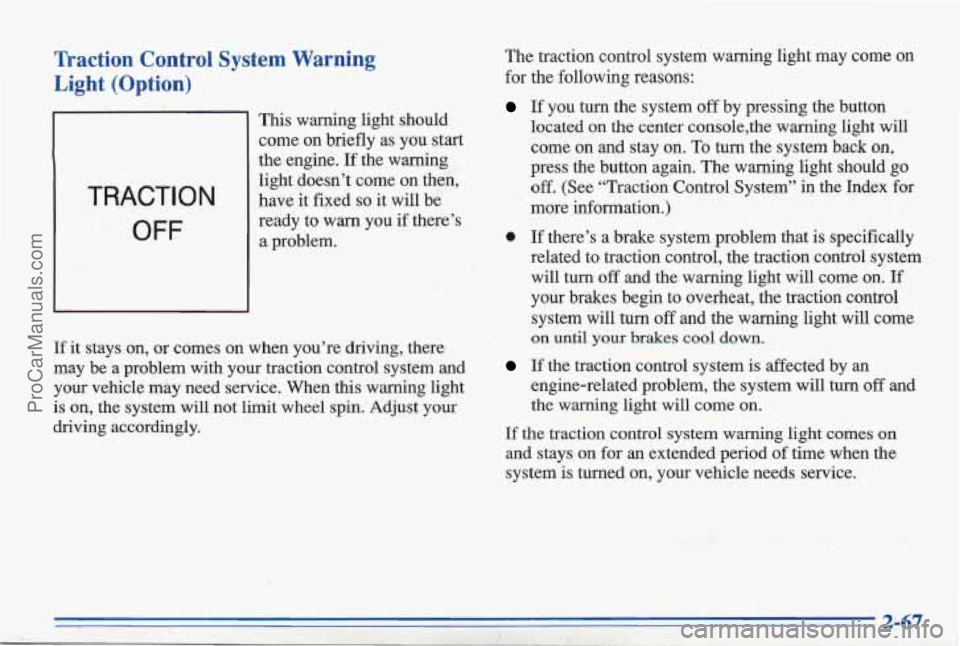
Traction Control System Warning Light (Option)
TRACTION
OFF
This warning light should
come on briefly as you start
the engine.
If the warning
light doesn’t come on then,
have it fixed
so it will be
ready to warn you
if there’s
a problem.
If it stays on, or comes on when you’re mvmg, there
may be a problem with your traction control system and
your vehicle may need service. When this warning light
is
on, the system will not limit wheel spin. Adjust your
driving accordingly. The
traction control system warning light may come on
for the following reasons:
If you turn the system off by pressing the button
located
on the center console,the warning light will
come on and stay
on. To turn the system back on,
press the button again. The warning light should go
off. (See “Traction Control System” in the Index for
more information.)
related to traction control, the traction control system will turn off and the warning light will come on.
If
your brakes begin to overheat, the traction control
system will turn
off and the warning light will come
an until your brakes cool down.
0 If there’s a brake system problem that is specifically
If the traction control system is affected by an
engine-related problem, the system will
turn off and
the warning light
will come on.
If the traction control system warning light
comes on
and stays on for an extended period of time when the
system is turned on, your vehicle needs service.
ProCarManuals.com